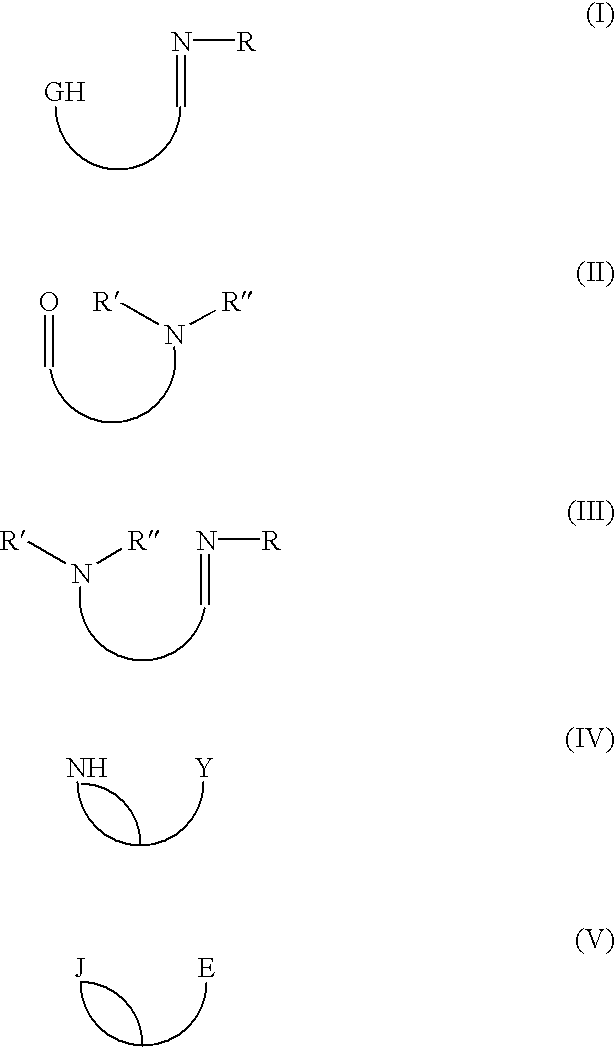Olefin polymerization catalysts and processes for making and using same
a technology of olefin polymerization and catalyst, which is applied in the direction of physical/chemical process catalyst, organic compound/hydride/coordination complex catalyst, organic chemistry, etc., can solve the problems of high sensitivity and difficult handling of catalysts
- Summary
- Abstract
- Description
- Claims
- Application Information
AI Technical Summary
Problems solved by technology
Method used
Image
Examples
second embodiment
the subject invention is directed to a process of forming the neutral chelate in-situ in a polymerization process medium. In this embodiment the precursor ligand I-V and the late transition metal agent XVI described above are introduced into the polymerization zone to initiate and catalyze the polymerization of an olefin or of the copolymerization of an olefin and a functionalized olefin or cyclic olefin.
The polymerization may be carried out at conventional temperatures (e.g., about -100.degree. C. to about +200.degree. C., preferably from -20.degree. C. to +100.degree. C., and most preferably between 0.degree. C. and 70.degree. C.). All ranges of temperatures being covered by this teaching. The pressure of the polymerization may be from atmospheric pressure to about 100 MPa or more, with all ranges of pressure being covered by this teaching. The polymerization is preferably carried out in a liquid which also acts as a liquid medium in which the ligand and the transition metal agent...
examples
The general method used for synthesizing phosphine-free nickel(II) complexes involved the use of N,N,N',N'-tetramethylethylenediamine-(dimethyl)nickel(II) or (tmeda)Ni(CH.sub.3).sub.2 as prepared by the method of W. Kaschube et al, J. Organomet. Chem., 355 (1988) 525-532. Reaction of this dialkylnickel(II) complex with various salicylaldimine bidentate ligands which were prepared previously using procedures described by C. Wang et al. in WO 98 / 42664 and Organometallics 1998, 17 (3149-3151) gave active single site catalysts for olefin polymerization. Unexpectedly, the resultant nickel(II) methyl complexes could only be isolated as storage-stable chelates when a Lewis base (e.g., acetonitrile, pyridine) was present during formation of the complex and electron-withdrawing groups (e.g., nitro, chloro) were absent from the salicylaldimine ligand. If electron-withdrawing substituents were present, then side-reactions such as formation of a bis-ligand complex occurred during attempts to is...
examples 1
In a dry box, 9-anthracenylsalicylaldimine (0.58 g, 1.28 mmol) and (tmeda)Ni(CH.sub.3).sub.2 (0.26 g, 1.29 mmol) were weighed and placed into a Schienk tube, which then was placed on a vacuum line. Anhydrous acetonitrile (5 mL) was added to the flask by cannula. The reaction solution changed from an orange color to a red color within about 5 minutes and an evolution of bubbles (methane) was noted. After about 2 hours, crystals formed on the inside of the Schlenk tube. After about 8 hours, the dark red crystals were allowed to settle to the bottom of the flask, and the acetonitrile supernate was decanted.
The yield of red crystalline solid after drying was 0.51 g (68%). .sup.1 H NMR (CD.sub.2 Cl.sub.2, 300 MHz, 25.degree. C.): .delta. -1.41 (s, 3H, CH.sub.3 Ni), 1.12, 1.33 (d, 6H, CH(CH.sub.3).sub.2), 1.86 (s, 3H, CH.sub.3 CN), 3.83 (septet, 1H, CH(CH.sub.3).sub.2), 6.6-8.4 (m, 18H).
PUM
| Property | Measurement | Unit |
|---|---|---|
| temperature | aaaaa | aaaaa |
| temperature | aaaaa | aaaaa |
| temperatures | aaaaa | aaaaa |
Abstract
Description
Claims
Application Information
 Login to View More
Login to View More - R&D
- Intellectual Property
- Life Sciences
- Materials
- Tech Scout
- Unparalleled Data Quality
- Higher Quality Content
- 60% Fewer Hallucinations
Browse by: Latest US Patents, China's latest patents, Technical Efficacy Thesaurus, Application Domain, Technology Topic, Popular Technical Reports.
© 2025 PatSnap. All rights reserved.Legal|Privacy policy|Modern Slavery Act Transparency Statement|Sitemap|About US| Contact US: help@patsnap.com



